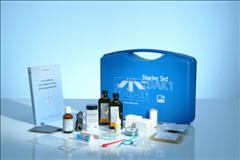 Cement your strain gauge adhesive knowledge in the next 90 seconds with this primer
Cement your strain gauge adhesive knowledge in the next 90 seconds with this primer
October 28, 2014 REDWIRE is news you can use from leading suppliers. Powered by FRASERS.
Posted by Durham Instruments
One Source For All Your Quantitative Measuring Needs. With Over 50 Yrs.Of Experience In The Instrumentation Field. It Of... Read more
Subscribe
Free REDWIRE e-newsletter

An old adage says if you fail to plan, you plan to fail. While this maxim rings true, so does the reality that the correct bonding agent contributes to the overall success or failure of strain gauge installation.
A strain gauge is not a ready-made measurement tool: only through the magic of bonding can the strain gauge accurately perform its measurement tricks. Bonding agents connect the strain gauge firmly to the surface of the specimen in order to transfer the deformation of the specimen correctly to the gauge.
Let the following information stick to you like glue as you reinforce your adhesive knowledge with our 90-second primer on strain gauge adhesives. Need more than a short tutorial? Contact Durham Instruments now for more in depth details on our line of strain gauge adhesives.
Types of strain gauge adhesives
Various kinds of adhesives are available depending on the working conditions of the installation site as well as the specifications of the effectiveness of adhesives, namely, its service temperatures.
Matching the appropriate strain gauge with its proper adhesive type is critical in achieving optimum performance. Ensure only that the recommended strain gauge adhesive is used for its associated strain gauge, which must include considerations beyond mechanical or technological connection suitability.
Depending on the installation technology, one can differentiate the features between cold curing adhesives, hot curing adhesives and spot welding methods.
Cold curing adhesives
- Cold curing adhesives are easy to apply and require little effort, which is used in applications such as experimental stress analysis.
- These types of adhesives are either
- single component adhesives – starts curing when air is excluded, or anaerobic curing
or
- two component adhesives – are ones that have to be mixed prior to installation
- single component adhesives – starts curing when air is excluded, or anaerobic curing
- Cold curing strain gauge adhesives include X60 (Methylmetacrylate) for stress analysis applications within the temperature range of -20°C to 50°C, but can also be used for measurements as low as -200°C.
- Z70 (Cyanoacrylate) is another cold curing adhesive option that cures in seconds, which also has higher temperature limits compared to X60 but requires a high speed of operation. Top applications for Z70 include the design and production of transducers in the medium to higher accuracy classes.
Hot curing adhesives
- Unlike cold curing adhesives, hot curing adhesives offer a wider application range at higher temperatures and meet higher requirements of accuracy.
- Hot curing adhesives are used usually in combination with precision gauges in the production of transducers and are only installed if the specimen can be heated to the temperature required for curing.
- Hot curing adhesives like the transparent silicon resin solvent SL450 is suitable for high temperature use up to 450°C but is also effective in curing condition temperatures ranging from 95 °C to 315°C.
Spot welding
- Spot welding is another simple installation method that requires little expenditure in equipment such as a spot welder (and perhaps a bit of training).
- The shortcomings to this method are the limited availability of special gauge types, in addition to that weldable gauges can only be manufactured down to a certain size, is a limiting factor in providing a range of applications.
- Specimens must also be made of weldable material, which may be prohibited for some sample applications despite weldability due to the danger of micro-corrosion on highly stressed parts of vapour vessels or austenitic steel, for example.
Share
Posted by Durham Instruments
One Source For All Your Quantitative Measuring Needs. With Over 50 Yrs.Of Experience In The Instrumentation Field. It Of... Read more
